Severity of hearing loss
Hearing loss is also measured in decibels (dB). Conversational speech is around 60dB. The degrees of hearing loss include:
Degree of Hearing Loss
Degree of hearing loss refers to the severity of the loss. The numbers are representative of the patient's thresholds, or the softest intensity at which sound is perceived. The following is one of the more commonly used classification systems:
| Degree of
hearing loss | Hearing loss
range (dB HL) |
|---|---|
| Normal | -10 to 15 |
| Slight | 16 to 25 |
| Mild | 26 to 40 |
| Moderate | 41 to 55 |
| Moderately severe | 56 to 70 |
| Severe | 71 to 90 |
| Profound | 91+ |
Source: Clark, J. G. (1981). Uses and abuses of hearing loss classification. Asha, 23, 493-500.
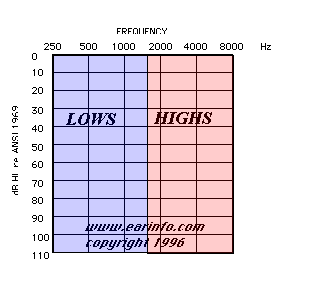
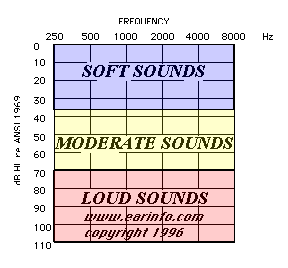
So once your graph is filled in (x represents the left ear, o the right), ... it shows your hearing sensitivity for different frequencies at different intensities (at different pitches and different volumes).
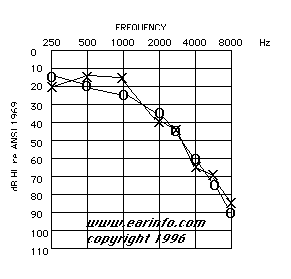
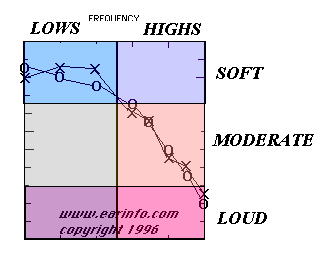
Hearing is NOT measured in percentages. Instead, it is measured in an arbitrary unit of loudness called the DECIBEL. The decibel (dB, or dB HL) is a logrithmic scale. Physically, every 6 dB increase represents a doubling of sound pressure level. Perceptually, every 10 dB increase sounds twice as loud.
Every increase of 10 decibels (10 dB) sounds twice as loud. 20 dB sounds twice as loud as 10 dB... 40 dB sounds twice as loud as 30 dB and 8 times as loud as 10 dB (10 to 20 to 30 to 40 = 2 x 2 x 2 = 8).
Normal hearing ranges from 0 to 20 dB in all frequencies.
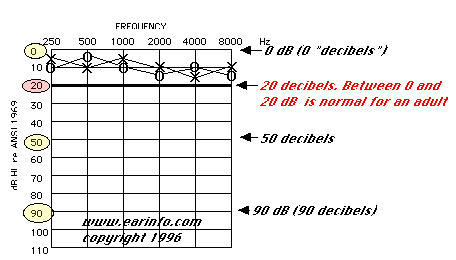
Damaged hair cells and deafness There are a series of hair cells contained in the cochlea (inner ear) that are key to most people's hearing. They are called the "inner hairs" (more on this later). It is damage to, or lack of the inner hair cells that cause most deafness. High decibels i.e. loud music or sounds above 140 db. will cause some of these hairs to die, as will some serious infections. Once an inner hair dies, it cannot be replaced. Because we initially are born with only about 3500 of these hairs, loss of a few can make a big difference in our hearing capacity.
 The Cochlea
The Cochlea The cochlea is the second part of the inner ear and is the actual organ of hearing. It is embedded in the skull in what is called the mastoid area, a spongy part of the skull just behind where the jaw hinges. The mastoid bone acts as an amplifier for some sounds, especially those in the lower frequency ranges.
The cochlea is made up of:
- The vestibular canal (scala vestibuli)
- The tympanic canal (scala tympani)
- The cochlear canal (scala media) that contains the Organ of Corti which in turn contains:
- The hairs that move when pressure waves of a certain frequency move the basilar membrane under them (inner hairs)
- Stiffer hairs (outer hairs) that run parallel to the inner hairs and act as inner hair and basilar membrane inhibitors
- The basilar membrane in which the inner hairs are embedded that transmits fluid movement to the inner hairs
- The tectorial membrane in which the tops of the outer hairs are lightly embedded
- The auditory nerves that run through the middle of the cochlea from the opening to close proximity to the helicotrema. These nerves from the inner hair roots link to the 8th nerve that transmit information to the brain

How the Various Canals Work
The cochlea begins at the oval window where the middle ear stirrup is attached and curves into a shape that resembles a snail shell, where the chambers get narrower towards the end. The coiled tube inside the snail-like apparatus contains three parallel canals discussed above, that run the length of the cochlear envelope.
Hearing loss
Conductive Hearing Loss
Conductive hearing loss occurs when sound is not conducted efficiently through the outer ear canal to the eardrum and the tiny bones, or ossicles, of the middle ear. Conductive hearing loss usually involves a reduction in sound level, or the ability to hear faint sounds. This type of hearing loss can often be medically or surgically corrected.
Examples of conditions that may cause a conductive hearing loss include:
- Conditions associated with middle ear pathology such as fluid in the middle ear from colds, allergies (serous otitis media), poor eustachian tube function, ear infection (otitis media), perforated eardrum, benign tumors
- Impacted earwax (cerumen)
- Infection in the ear canal (external otitis)
- Presence of a foreign body
- Absence or malformation of the outer ear, ear canal, or middle ear
My boys cannot hear the low tones very good but the high tones they can hear better. The doctors are not sure why they would flow against the majority but in most ways they do just that. They have a Moderately Severe rising to Mild loss. I am going to post and audiogram and put green 'x' on the places that my son's hear at so you know the red part is where normal people hear and the green is where my boys hear at.

This is as good as I could do showing you what my boys hear like with out looking at an audiogram. Since I can't find one at the moment. But it looks almost identical to this. One of my boys do wear hearing aids and the other should be he keeps getting infections in his ears and so it is hard to have him were any at the moment. From the charts at the tops of this post you can see what a normal hearing loss looks like.
Wow this is one crazy post so if it helps you in any way please feel free to let me know. Thanks.


